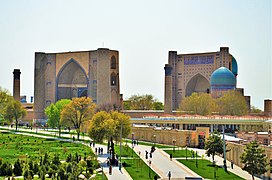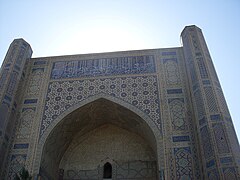Bibi-Khanym Mosque: Difference between revisions
R9tgokunks (talk | contribs) |
R9tgokunks (talk | contribs) |
||
| Line 26: | Line 26: | ||
== History == |
== History == |
||
[[File:Main enterance 02.JPG|200px|thumb|Stone Koran stand]] |
[[File:Main enterance 02.JPG|200px|thumb|Stone Koran stand]] |
||
[[File:Рихард-Карл Карлович Зоммер - Самарканд, Узбекистан.jpg|thumb|left|The ruins of the Mosque as depicted in ''Samarkand'', by Richard-Karl Karlovitch Zommer]] |
[[File:Рихард-Карл Карлович Зоммер - Самарканд, Узбекистан.jpg|thumb|left|The ruins of the Mosque around the turn of the century, as depicted in ''Samarkand'', by Richard-Karl Karlovitch Zommer]] |
||
After his [[Timur#Indian campaign|Indian campaign]]<ref name="skiouros">{{cite web|url=http://www.skiouros.net/voyages/2000/uz/uz2000_103.en.html |title=Bibi-Khanym mosque |accessdate=2007-04-06 |publisher=Skiouros.net }}{{dead link|date=November 2016 |bot=InternetArchiveBot |fix-attempted=yes }}</ref> in 1399 [[Timur]] decided to undertake the construction of a gigantic mosque in his new capital, [[Samarkand]]. |
After his [[Timur#Indian campaign|Indian campaign]]<ref name="skiouros">{{cite web|url=http://www.skiouros.net/voyages/2000/uz/uz2000_103.en.html |title=Bibi-Khanym mosque |accessdate=2007-04-06 |publisher=Skiouros.net }}{{dead link|date=November 2016 |bot=InternetArchiveBot |fix-attempted=yes }}</ref> in 1399 [[Timur]] decided to undertake the construction of a gigantic mosque in his new capital, [[Samarkand]]. |
||
Revision as of 05:29, 22 April 2018
| Bibi-Khanym Mosque | |
|---|---|
 Façade | |
| Religion | |
| Affiliation | Islam |
| Location | |
| Location | Samarkand, Uzbekistan |
| Architecture | |
| Type | Mosque |
| Style | Azeri |
| Completed | 1404 |
| Dome height (outer) | 40 m |
The mosque Bibi-Khanym Mosque (Persian: مسجد بی بی خانم; Uzbek: Bibi-Xonum machiti; Russian: Мечеть Бибиханым; also: ... Khanum / Khanom / Hanum / Chanym / Hanim, etc.) is one of the most important monuments of Samarkand. In the 15th century it was one of the largest and most magnificent mosques in the Islamic world. By the mid-20th century only a grandiose ruin of it still survived, but now major parts of the mosque have been restored.

History


After his Indian campaign[1] in 1399 Timur decided to undertake the construction of a gigantic mosque in his new capital, Samarkand.
When Timur (Tamerlane) returned from his military campaign in 1404 the mosque was almost completed. However, Timur was not happy with the progress of construction, therefore he had immediately made various changes, especially concerning the main cupola.[2]
From the beginning of the construction, problems of statistical regularity of the structure revealed themselves. Various reconstructions and reinforcements were undertaken in order to save the mosque. However, after just a few years, the first bricks had begun to fall out of the huge dome over the mihrab.[3] It forced Timur to retaliate often beyond the structural rules. His builders were certainly aware of that, however he didn't want to accept their opinion and reality. [4][5]
In the late 16th century the Abdullah Khan II (Abdollah Khan Ozbeg) (1533/4-1598), the last Shaybanid Dynasty Khan of Bukhara, cancelled all restoration works in Bibi Khonym Mosque.[6] After that, the mosque came down and became a ruins gnawed at by the wind, weather, and earthquakes. The inner arch of the portal construction collapsed in 1897.[7][8] During the centuries the ruins were plundered by the inhabitants of Samarkand in search of building material especially the brick of masonry galleries along with the marble columns.
A first basic investigation and securing the ruins was made in Soviet times. Late in the 20th century, the Uzbek government began restoration of three dome buildings and the main portal. In 1974 the government of the then-Uzbek SSR began the complex reconstruction of the mosque.[9] The decoration of domes and facades was extensively restored and supplemented. Work on the mosque restoration continues now.
Architecture
The mosque follows the basic plan of the courtyard mosque. Its outer walls enclose a rectangular area which measures 167 metres (182.63 yards) in length and 109 metres (119.20 yards) wide and runs roughly from northeast to southwest - the Qibla accordingly. However the size of the site vacant of covered galleries was only 78 by 64 meters.[10]

Entering the Mosque from the northeast through the vast (35 metres high)[11] parade portal leads to the courtyard. A monumental dome above a square base, around 40m [12] high, rises on the opposite site of the courtyard. The dome is the largest cupola of the mosque. Nevertheless, the dome cannot be seen from the courtyard, for whole building is covered up from inside by the grandiose pischtak, which framed a monumental, deeply embedded Iwan. The Iwan does not allow getting inside the underlying construction supporting the dome; this can only be done from the sides. Two other domes associated with the Iwans, more modest in their size, are facing at the center of the long sides of the courtyard. Thereby, the Bibi Khonym Mosque implements the classic Persian-Islamic architectural type of the "Four-Iwan scheme" [13]
Formerly, there were open galleries measuring 7.2 m high inside the courtyard. Their cover was formed from the juxtaposition of many small, flat brick vaults and domes supported by a forest of more than 400 marble columns and buttresses. Today, only hints of the galleries can be seen.[10]
Four minarets at the outer corners of the site have been restored. Four other, more majestic minarets that flanked the Portal arch of the entrance and the Pischtak of the main domed building are not completed yet.
In the middle of the courtyard is located the stone pedestal - the huge Quran stand [14] crafted from ornate marble blocks. This remarkable sight originates from the time of Timur.
The huge Bibi Khonym Mosque with its three domed rooms, the covered galleries and the open courtyard was intended to gather the entire male population of Samarkand city for the joint Friday prayers.[10]
In the construction of three domes of Bibi-Khanym mosque, sophisticated in Timur's time, one important innovation was applied: a two-fold construction, where the internal dome hall neither by the form nor by height corresponds to the dome's shape from outside. There is a hollow space between the inner ceiling and the outer cupola. This dome construction allowed the main hall of the mosque to be committed to the proportions and the aesthetics of the 30 m high interior above the mihrab. Meanwhile, the 40 m high outer dome of the main building could be designed for maximal impression and visibility. This scheme was applied also to the lateral dome structures that allowed making modest buildings the figuration tower-like structures with elegant melon-shaped and longitudinally ribbed outer domes.[10]
Gallery
-
Façade
-
1 Façade
-
2 Façade
See also
References
- ^ "Bibi-Khanym mosque". Skiouros.net. Retrieved 2007-04-06.[permanent dead link]
- ^ Зохидов, Пўлат: Темур даврининг меъморий кахкашони. Тошкент: Шарқ 1966. [Zakhidov, Pulat: Architectural glories of Temur’s era. Tashkent: Sharq 1996.] p. 58
- ^ Самарканд. Бухара. Галина Пугаченкова. «Искусство» 1968 г. p. 30
- ^ "Samarkand City". Stantours.com. April 24, 2002. Archived from the original on 3 May 2007. Retrieved 2007-04-06.
{{cite web}}: Unknown parameter|deadurl=ignored (|url-status=suggested) (help) - ^ "Highlights of CA" (PDF). Steppes Travel. March 22, 2006. Archived from the original (PDF) on September 30, 2007. Retrieved 2007-04-06.
{{cite web}}: Unknown parameter|dead-url=ignored (|url-status=suggested) (help) - ^ Зохидов, Пўлат: Темур даврининг меъморий кахкашони. Тошкент: Шарқ 1966. [Zakhidov, Pulat: Architectural glories of Temur’s era. Tashkent: Sharq 1996.] p. 59
- ^ Зохидов, Пўлат: Темур даврининг меъморий кахкашони. Тошкент: Шарқ 1966. [Zakhidov, Pulat: Architectural glories of Temur’s era. Tashkent: Sharq 1996.] p. 57
- ^ "Bibi Khanym Mosque". TripAdvisor.com. Retrieved 2007-04-06.
- ^ "Bibi Khanym Mosque". iExplore.com. July 14, 2001. Archived from the original on December 22, 2007. Retrieved 2007-04-06.
{{cite web}}: Unknown parameter|deadurl=ignored (|url-status=suggested) (help) - ^ a b c d Dmitriy Page. "Bibi-Khanym Mosque in Samarkand". Retrieved October 6, 2015.
- ^ Carillet, Joel (June 6, 2006). "In Pictures: Samarkand, Uzbekistan". Gather.com. Archived from the original on 2007-02-11. Retrieved 2007-04-06.
{{cite web}}: Unknown parameter|deadurl=ignored (|url-status=suggested) (help) - ^ Muzey.uz, Соборная мечеть Биби-Ханым Archived 2007-11-21 at the Wayback Machine (Bibi-Khanym Mosque) Template:Ru icon
- ^ Alfred Renz: Geschichte und Stätten des Islam von Spanien bis Indien. Prestel, München 1977. ISBN 3-7913-0360-0.
- ^ Burnett, Doug (September 7, 2000). "Uzbekistan 2000 - Samarkand". BootsnAll.com. Retrieved 2007-04-06.







